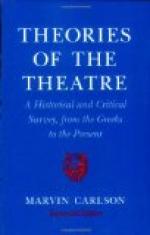It is also customary in the drama to emphasise by proportion. More time is given to significant scenes than to dialogues of subsidiary interest. The strongest characters in a play are given most to say and do; and the extent of the lines of the others is proportioned to their importance in the action. Hamlet says more and does more than any other character in the tragedy in which he figures. This is as it should be; but, on the other hand, Polonius, in the same play, seems to receive greater emphasis by proportion than he really deserves. The part is very fully written. Polonius is often on the stage, and talks incessantly whenever he is present; but, after all, he is a man of small importance and fulfils a minor purpose in the plot. He is, therefore, falsely emphasised. That is why the part of Polonius is what French actors call a faux bon role,—a part that seems better than it is.
In certain special cases, it is advisable to emphasise a character by the ironical expedient of inverse proportion. Tartufe is so emphasised throughout the first two acts of the play that bears his name. Although he is withheld from the stage until the second scene of the third act, so much is said about him that we are made to feel fully his sinister dominance over the household of Orgon; and at his first appearance, we already know him better than we know any of the other characters. In Victor Hugo’s Marion Delorme, the indomitable will of Cardinal Richelieu is the mainspring of the entire action, and the audience is led to feel that he may at any moment enter upon the stage. But he is withheld until the very final moment of the drama, and even then is merely carried mute across the scene in a sedan-chair. Similarly, in Paul Heyse’s Mary of Magdala, the supreme person who guides and controls the souls of all the struggling characters is never introduced upon the scene, but is suggested merely through his effect on Mary, Judas, and the other visible figures in the action.
One of the easiest means of emphasis is the use of repetition; and this is a favorite device with Henrik Ibsen. Certain catch-words, which incorporate a recurrent mood of character or situation, are repeated over and over again throughout the course of his dialogue. The result is often similar to that attained by Wagner, in his music-dramas, through the iteration of a leit-motiv. Thus in Rosmersholm, whenever the action takes a turn that foreshadows the tragic catastrophe, allusion is made to the weird symbol of “white horses.” Similarly, in Hedda Gabler—to take another instance—the emphasis of repetition is flung on certain leading phrases,—“Fancy that, Hedda!” “Wavy-haired Thea,” “Vine-leaves in his hair,” and “People don’t do such things!”




